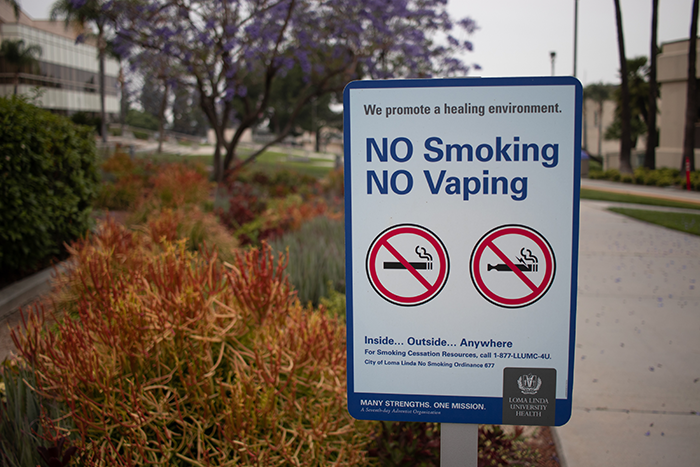Vaping, also known as electronic cigarette (e-cigarette) use, has become increasingly popular among young adults. In recent years, adolescents have been starting to vape at younger ages at a higher intensity.1 With e-cigarettes becoming the primary form of nicotine use among adolescents,1 it is crucial to understand the truth about vaping and its potential risks on college campuses.
In this comprehensive guide, we will explore the facts surrounding e-cigarette use, discuss its health effects, and share effective prevention strategies for college students. Read on to learn more about the issue of vaping and how to minimize its use among your students.
What is vaping?
Vaping involves the use of electronic cigarettes to inhale aerosols produced by heating a liquid.2 E-cigarettes can take many forms, including disposable e-cigarettes, vape pens, and tank systems.2

The aerosol produced by e-cigarette devices can contain various substances, including nicotine, ultrafine particles that can get into the lungs, flavorings, marijuana, cancer-causing chemicals, and heavy metals.2
Most e-cigarettes contain nicotine, a highly addictive substance that can alter brain pathways and affect learning, stress, and self-control.1 Adolescents are more likely to become addicted than older adults because their young brains are still developing.1
The health risks of e-cigarettes
Harmful chemical exposure
Vaping exposes users to harmful chemicals that can damage the lungs, cause cancer, and lead to addiction.3 The aerosols produced by vaping devices have been shown to contain a variety of toxic, carcinogenic, disease-causing chemicals and substances.3
Neurological effects
Nicotine in e-cigarettes can damage the developing adolescent brain, particularly areas responsible for attention, learning, mood, and impulse control.2 In addition to affecting brain development, use of e-cigarettes also increases the likelihood of addiction to other substances in the future.2
Vaping has a similar neurological impact as other forms of nicotine, meaning users may be at increased risk of neurologic conditions, including stroke, addiction, and cognitive dysfunction.4
Respiratory issues
Vaping has been linked to serious lung conditions, including e-cigarette or vaping-associated lung injury (EVALI).5 EVALI has been shown to be caused by substances in e-cigarettes, primarily vitamin E acetate.5
EVALI can cause myriad symptoms, including shortness of breath, cough, chest pain, fever, chills, diarrhea, nausea, vomiting, and rapid heart rate.5 As of February 2020, there were more than 2,800 hospitalizations from EVALI across the nation.5
In addition, e-cigarette users have an increased risk of getting certain chronic diseases, including asthma.4
5 ways to reduce vaping on campus
Keeping your students and campus addiction-free supports the health, well-being, and success of your students. Learning how to decrease the prevalence of vaping on campus can help you in several ways.

Here are five ways to combat vaping on your campus and help build a strong drug-free campus:
1. Educate students, faculty, and parents
Education is the first step in prevention. Students who do not understand the risks associated with vaping are more likely to try it.
Consider incorporating vaping and other drug prevention education into your curriculum. Disseminate information about vaping publicly on campus, whether through flyers, pamphlets, videos, group discussions, or in-person presentations.
The importance of education also applies to faculty and parents. When adult role models understand the health risks of vaping, they are more likely to advocate for a drug-free campus and support students working to break free from drug dependence.
2. Lead by example
Another important way to keep students away from e-cigarette use is to lead by example.2 Students are more likely to try substances if they see other people using them.
Discouraging e-cigarette use among students, faculty, and visitors can help prevent students from seeing vaping as socially acceptable, decreasing its allure. Enact policies that forbid the use of cigarettes and e-cigarettes in buildings and on campus property.

Another way to lead by example is to launch a campus-wide vape prevention campaign organized by students. Having the social endorsement of peers can help the message have a greater impact on students.
3. Provide support resources
Personal support is essential for students who are addicted to vaping and on the road to recovery. Quitting e-cigarettes can be challenging because of the addictive nature of nicotine. However, with the right support on campus, it is possible for students to overcome this addiction.
Make sure your campus provides robust support for students struggling with substance use, such as counseling, support groups, educational resources, and healthcare. Helping students feel supported in their effort to become drug-free makes them more likely to achieve success.
Check with your students’ health insurance plan to ensure students have adequate coverage for drug cessation treatment, which may include doctor visits, counseling visits, and medications, depending on the needs of each student.
4. Encourage healthy living
Another important way to reduce vaping use on campus is to promote healthy living among students. Students who are eating proper nutrients, hydrating effectively, getting sufficient sleep, and exercising regularly are less likely to turn to drugs.
Healthy eating
Ensure students have proper education on healthy eating, and provide a variety of whole foods, fruits, and vegetables in your campus dining centers.
Hydration
Proper hydration is another key element of health and overall wellness. Ensure students can easily access hydration stations in every building, and encourage them to drink plenty of water throughout the day.
Exercise
Provide students with access to athletic facilities where they can exercise in the way that suits them best. This may include yoga classes, intramural sports leagues, and access to facilities such as weight rooms, racquetball courts, pools, and basketball courts.

Physical activity can help provide a healthy outlet for stress relief and reduce the likelihood that students will turn to vaping for stress relief.
Sleep
In addition to healthy eating and exercise, having proper sleep hygiene and getting adequate rest can help students decrease stress and reduce their likelihood of turning to stimulants like nicotine to maintain their energy levels.
Stress reduction
Developing healthy coping mechanisms for stress can help students keep from turning to vaping and other substance use.
Provide on-campus opportunities for stress relief, such as meditation, yoga, deep breathing, exercise classes, outdoor activities, intramurals, or peer groups. Finding healthy stress solutions can help students remain drug-free.

5. Build a strong community
Another way to help students remain drug-free is to promote a healthy connection among students and faculty on campus. Students who feel a part of a welcoming community are less likely to turn to drugs, so building your campus community can be beneficial. This may include programs such as peer mentoring programs, student interest groups, and other groups where students can connect with peers and share their experiences and struggles.
Learn more about Wellfleet
By implementing effective prevention strategies and providing needed support, it’s possible to reduce e-cigarette use on your campus and help your students live healthier, drug-free lives.
At Wellfleet, we prioritize the health and wellness of our student members. We know how important it is for students to be at their best mentally, emotionally, and physically — and remaining drug-free is an important factor in achieving that goal.
Wellfleet’s student health insurance plans always put students’ needs first, and we tailor our plans to the needs of your campus.
Connect with our team to learn more about how our student-centric approach to health insurance can benefit your campus and help your students get the care they need.
Resources
1 Glantz, S, et al. (2022, November 7). Nicotine Addiction and Intensity of e-Cigarette Use by Adolescents in the US. JAMA Network. https://jamanetwork.com/journals/jamanetworkopen/fullarticle/2798130.
2 CDC. (2023, November 2). Quick Facts on the Risks of E-cigarettes for Kids, Teens, and Young Adults. https://www.cdc.gov/tobacco/basic_information/e-cigarettes/Quick-Facts-on-the-Risks-of-E-cigarettes-for-Kids-Teens-and-Young-Adults.html.
3 National Academies of Sciences, Engineering, and Medicine, et al. (2018, January 23). Toxicology of E-Cigarette Constituents. Public Health Consequences of E-Cigarettes. https://www.ncbi.nlm.nih.gov/books/NBK507184/#:~:text=Substances%20identified%20in%20e%2Dcigarette,%2C%20tobacco%20alkaloids%2C%20and%20drugs.
4 Lopez-Ojeda, W, and Hurley, R. (2024, January 16). Vaping and the Brain: Effects of Electronic Cigarettes and E-Liquid Substances. The Journal of Neuropsychiatry and Clinical Neurosciences. https://neuro.psychiatryonline.org/doi/full/10.1176/appi.neuropsych.20230184?af=R.
5 Yale Medicine. E-cigarette, or Vaping Product, Use Associated Lung Injury (EVALI). https://www.yalemedicine.org/conditions/evali#:~:text=EVALI%20is%20a%20serious%20medical,vapor%20that%20can%20be%20inhaled.
CSR-SHIP-JANUARY-2024-5


